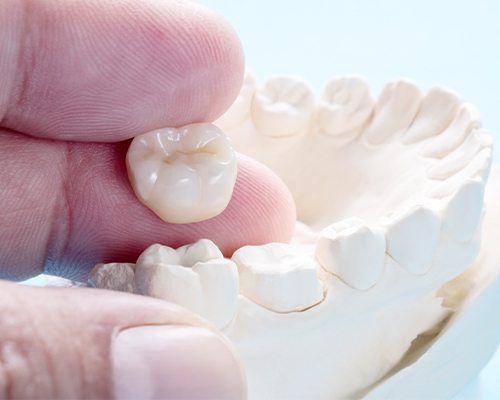
ODDZIAŁY
Opis usługi
Crowns are permanent dental restorations used when there is irreversible, extensive damage to the hard tissues of the tooth due to caries or loss of the natural dental crown caused by trauma. This type of treatment requires several visits to the dental practice, but afterwards you can enjoy healthy and functional teeth.
Dental crowns enable to regain not only the full functionality of a relevant tooth, but also improve its aesthetics. A crown may be placed only if caries and/or periodontal disease have been previously treated, on a properly polished tooth or on a previously implanted tooth. Therefore, apart from a prosthetic consultation, you may also need to consult another specialist before starting the treatment.
Dental crowns – indications
Dental crowns are used in the case of:
- extensive cariogenic lesions that are not eligible for restoration with a composite material,
- weakened teeth and teeth at risk of fracture (e.g. teeth after root-canal treatment or with large fillings),
- teeth after mechanical trauma,
- abnormally shaped teeth,
- discoloured teeth, in order to improve their aesthetics.
Dental crowns are also the last stage of implant treatment when replacing a single missing tooth.
Remember that dental crowns perfectly play the role of natural teeth in the oral cavity: they enable you to bite and chew food normally, and additionally improve the aesthetics of your smile.
Dental crowns – types
Depending on how the crowns are prepared, they can be made of a single material or of several materials. When it comes to the material from which dental crowns are made, the following are distinguished:
- porcelain crowns fused to metal: offer high durability and good aesthetic results,
- porcelain crowns fused to zirconium oxide: ensure high aesthetics and high durability, and cause no allergies,
- all-full ceramic crowns: high aesthetic value, difficult to distinguish from the patient’s natural teeth, especially recommended for the front teeth,
- composite crowns: by far the most affordable, although the uniform colour of the composite does not fully allow to match the natural colour of the patient’s natural neighbouring teeth. They are sometimes used as a temporary solution until the patient decides on a more costly treatment,
- metal crowns: inexpensive and very durable, but look unnatural and can cause allergies,
- temporary acrylic crowns: most often used while the patient waits for the preparation of the final crown.
What does the treatment look like?
Prosthetic treatment involving dental crowns requires several visits to the dental practice. Before starting the proper prosthetic treatment, the tooth must be treated in order to eliminate cariogenic lesions, and sometimes root-canal treatment is indicated. Only then does the prosthodontist properly prepare the tooth. In order to map the dental arches of the maxilla and the mandible, an impression is taken and then sent to the lab. A dental technician prepares a crown that recreates the anatomical structure of the patient’s dental crown. During the waiting time, the polished tooth surface is secured with a temporary acrylic crown. When the final dental crown is ready, the dentist will try it on and, if necessary, adjust the height of the crown and cement it permanently to the previously prepared tooth.
Contact form
Please complete the form below. We will call you back, tell you about the details of the offer and arrange an appointment for you.



